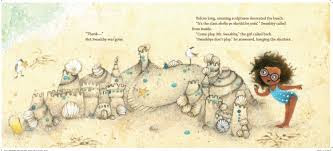"Meg tried to climb at night,
but dangling from a rope, studying leaves,
is difficult
and dangerous
in a dark forest
with deadly snakes
and spiders
and ravenous biting ants.
She had to find a better way.
She brainstormed with other scientists.
She thought and imagined ...
What if I fly up in a balloon?
Or work from the edges of hillsides?
Or train a monkey?"
I've been thinking this morning that Juana Martinez-Neal's Zonia would have loved to meet and have a conversation with Meg Lowman had they had the chance. Of course, Zonia's fictional love is for her beloved Amazon rainforest, Meg Lowman's life's work has been in many rainforests. Both played an active role is standing up for the forests they loved. Both are worthy of great admiration from those who read their stories.
It began in childhood when Meg's love for all trees consumed her thoughts, and led her through years of learning about them. She wanted to know everything she could; she realized that would only happen if she could find her way to the tops of them. There was very little to see from the ground.
"We had already been to the moon and back and nobody had been to the top of a tree."
She set her goals high, and moved her body higher. To do the work she wanted to do, she had to work hard at learning, discovering, and finding ingenious ways to study the canopies that no one else had studied. Following her many experiences, she wanted to teach others about the need to protect this world she so loved.
"To insects, a tree is not just a tree,
it is a "salad bar" -
all-you-can-eat leaves.
To birds and mammals, a tree is a buffet -
juicy fruits and plump beetles,
salamanders, and frogs.
A tree is a sponge,
soaking up water from the forest floor,
and a recycler,
giving water back to the clouds,
ready to quench another day's thirst."
Along with this marvelous description, the author adds an information 'leaf' with further information:
"When animals eat leaves and feed on dead
and weak trees, they return nutrients to the
soil through their digestion, nourishing trees and
future seedlings."
This is a picture book biography that exemplifies what is best about the books we are able to share with our children today. The text is inspiring and uplifting. It is filled with detailed descriptions, personal quotes from Ms. Lowman, additional learning at every turn, and compelling adventure. Jana Christy's digital illustrations constantly shift perspective, provide brilliant and useful details, and ensure that readers will want to slow down and take the time needed to observe the action, the beauty of the forests and the daring escapades of the book's inquisitive activist.
Heather Lang shares her impetus for writing this captivating book:
"I began my work on The Leaf Detective with a deep passion for our natural world. I’m in awe of its sounds, smells, sights, mysteries, and wonders. Every time I encounter stories about how we are destroying nature, I feel a sense of dread and desperation. We’ve already lost more than half of our forests. I knew from the outset I wanted to write a book that was both a biography and a science book about the rainforest. As I researched Meg Lowman, I was struck by the depth of her connection to trees— a connection that grew from profound respect, appreciation, love."
Please find a copy, and read it.





























































